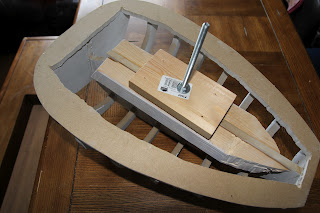I've used hide glue from Bjorn Industries
(http://www.bjorn.net/prod.htm) to assemble the mold. This glue comes
in dry form as little granules. You basically mix one part granules to
one part water and let it soak for 30 minutes, then heat in a double boiler until the glue reaches NO MORE than 140F. Anymore than that it will destroy the glue. After cooking the glue it can be placed in the refrigerator for several weeks and re-heated as necessary. This glue cleans up easily with water but ones dry the hold is permanent. I'm sure the pieces would break somewhere other than the glued joints.
So we begin with all the pieces laid out before us.
First we attach some support pieces to the spine that will later be used
to mount the whole mold on a home made universal joint during lute
construction. Then glue the spine and end pieces to the base.
The shot above shows the end where the instruments neck block will be attached. This is the first piece of the actual instrument to be worked on and will be chiseled to follow the contour of the spine.
Notice the end pieces on the two shots above. Those will be chiseled by hand to match the curve of the spine on each end.
UPDATE: A couple of things I learned during this step.
- I glued the 3 end pieces above together and then glued them onto the base & spine. This was a mistake as any misalignment of the 3 pieces will cause things to not line up well along the spine/base. Glue them onto the base/spine assembly one at a time to ensure good alignment.
- Make sure the glue is 140F while gluing!! The glue temperature had dropped a bit and one of the ribs did not glue well and came off during my chiseling later.
Then we begin adding all the supporting ribs until we end up with....
Notice the ends have now been chiseled to match the curve of the spine. I need to pay a bit more attention to this piece and make sure the 3 end pieces curve nicely while still maintaining the faceted edges the ribs will lay down on. Getting close!




















